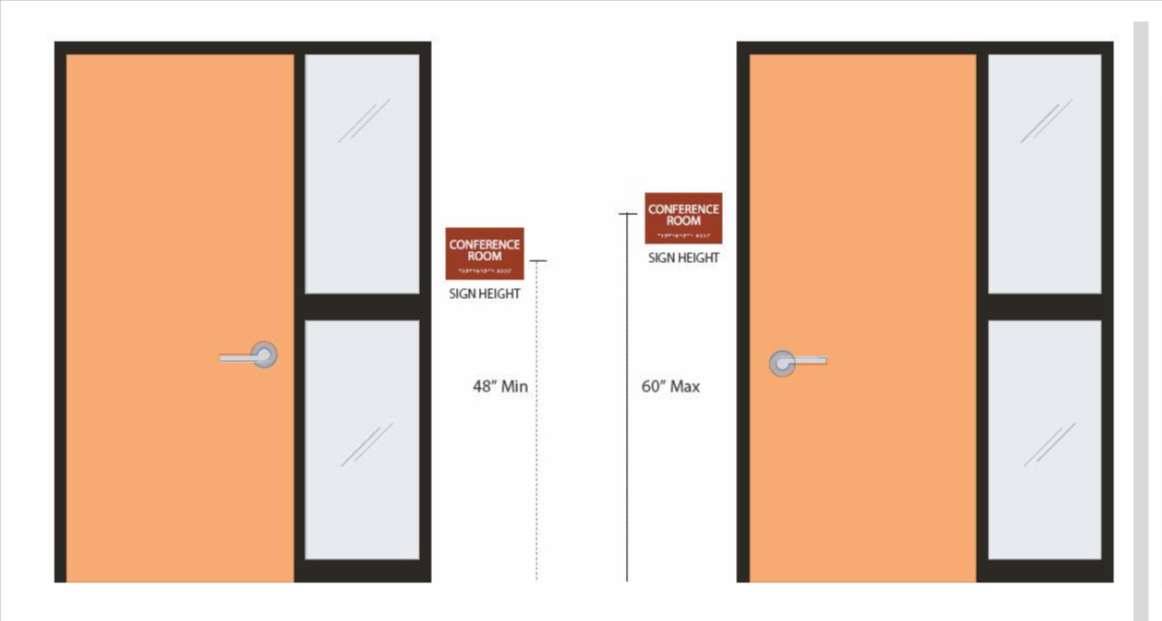The function of ADA signage is to make public areas easier to navigate for people with disabilities. ADA signs are important for a very simple reason: they are required by law. “ADA” stands for Americans with Disabilities Act, a law enacted in 1990 to prohibit discrimination against people with disabilities in all areas of public life, from transportation to jobs and education and everything in-between. ADA signs are required in every doorway in all U.S. public buildings, businesses, apartments, offices, and home businesses with visiting clients.
What makes a sign ADA-compliant?
The thing that stands out most about ADA signs is the raised letters called braille. The most well-known qualification for ADA signage is the raised text and braille letters on its surface. Raised round dots in specific shapes and patterns are what comprise braille, the written language for blind and visually impaired people. While braille is an important part of ADA regulations, many other factors are considered when creating ADA-compliant signs. The ADA Standards for Accessible Design have very specific requirements for every factor of ADA-compliant signage. Meeting these standards is necessary for any business, so let’s talk about some of the things that ADA signs must contain.
The basic requirements for the ADA standards require visual signs to have raised characteristics. The visual characters on a visual only ADA sign must have dark characters on a light background or light characters on a dark background creating high contrasting colors on the image. The sign must be in Sans Serif Font because this is one of the easiest fonts to read. Height Requirements on the tactile characters on ADA compliant sign should be hung so the bottom of the lowest tactile character or line of text measures 48″ (inches) from the finished floor, and the base of the highest tactile character is no more than 60″ (inches) from the floor.
Size and Space Requirements for ADA Signage
- ADA requirements specify a size range for text height of 5/8 – 2 inches. The most common size for text is ⅝ inches, and you need to allow 2 inches of height per line of text.
- For text that is larger, you must allow for 2 times the height of the characters, plus 1 inch per line of Braille.
- Pictograms must be 6 inches high.
- Text must be in simple, sans serif font, in a medium or bold weight. A tactile sign must be in UPPERCASE. Italics, scripts, and other hard-to-read fonts are not allowed.
- Visual only signs, such as overhead signs, may be in lowercase.

Do Exterior Signs Need to Be ADA Compliant?
ADA-compliant signs are not required in parking lots (except for accessible parking spaces), in areas not meant for public use, or outside of the building where a business’s name/address is provided.
Where IS ADA Signage Required?
Federal law requires tactile, raised character signs at every doorway. ADA sign requirements apply to the following types of buildings:
- Designations (signs identifying rooms and spaces)
- Directional and informational signs
- Means of egress/ Emergency exits
- Stores and Shops
- Restaurants and bars
- Theaters
- Hotels and motels
- Recreation Facilities
- Assembly areas
- Places of Educations
- Office Buildings
- Medical Facilities
- Factories
- Warehouses
- Manufacturing
- Apartments and Condo buildings
- Lobbies and Hallways
- Banks
- Commercial areas in private residence
Have more questions or want to discuss placing a signage order? Contact us today!


